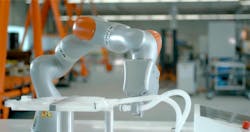Just over a decade ago, Microsoft was the ever-present technology provider in the manufacturing sector. Today the company remains the principal operating system partner for all the major—and not so major—industrial application vendors. But just over a decade ago, Microsoft was far more visibly active in the manufacturing sector with its acquisition of enterprise software companies such as Great Plains and Navision in the early 2000s to create its Dynamics GP and AX software, respectively.
Though Microsoft never disappeared from the industrial scene, its presence has been noticeably more subdued over the last several years. But that is changing, and Microsoft made that clear at Hannover Fair 2015 in Germany.
The impetus for Microsoft’s visible resurgence in manufacturing is the Industrial Internet of Things (IIoT)—a theme that ran though the company’s entire Hannover Fair exhibit. A key aspect of Microsoft’s exhibit at Hannover was not that it focused on the IIoT concept, but on the display of real world IIoT applications with Microsoft customers and partners such as Fujitsu, ThyssenKrupp, and KUKA Robotics.
In Fujitsu’s display the focus was on the transformation of the company’s old semiconductor manufacturing operations into the Akisai Plant Factory—a factory that integrates cutting-edge agricultural techniques with state-of-the-art manufacturing, information and communication technologies, such as the Fujitsu Akisai agricultural cloud based on Microsoft Azure. As an example of what goes on at this factory, a portion of the clean room areas are now used to produce lettuce that is low in potassium for consumption by dialysis patients and people with chronic kidney disease. All activities in the Akisai facility are tracked using Windows tablets connected to the cloud. Fujitsu also showed how its Eco-Management Dashboard, connected via the IIoT and machine-to-machine communication technologies, is being used to produce even higher-quality products and achieve greater productivity.
ThyssenKrupp’s display at the Microsoft booth featured a towering elevator mockup to show how the company is using IIoT technology to increase the reliability of its elevators. Using Microsoft Azure Machine Learning, ThyssenKrupp is creating a new preventive maintenance system that lets engineers access real-time data to prevent elevator breakdowns. The IIoT-connected elevators also provide condition reports that alert engineers to potential issues.
KUKA, a manufacturer of industrial robots and automation products, is using the Microsoft Azure IoT platform to blend IT with its collaborative iiwa (intelligent industrial work assistant) robots to assist humans in factory assembly applications. At the Microsoft booth, the KUKA iiwa was on display demonstrating how it can thread a tube into a small hole in the back of a dishwasher. Beyond the iiwa’s collaborative assembly capabilities, this exhibit demonstrated the use of Microsoft Azure IoT services, Kinect hardware, and the OPC-UA communication standard to blend IT with robotic technologies. Movement data from the robot is streamed to the Azure cloud where workers can monitor progress and receive status reports from the factory. Within this framework, assembly errors can be addressed in real time through Windows tablets, making the automated process faster and easier.
“The Azure cloud application in the KUKA demonstration allows users to view and act on data through a management dashboard, providing business analytics and trend intelligence,” said Caglyan Arkan, general manager of worldwide manufacturing & resources at Microsoft. “So, if a certain piece of the dishwasher assembly is breaking more frequently than other pieces, for example, advanced data stream analysis can help understand what may be causing the issue or use predictions to recommend pre-emptive repairs through machine learning technology.”
Leaders relevant to this article:


